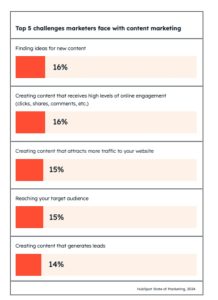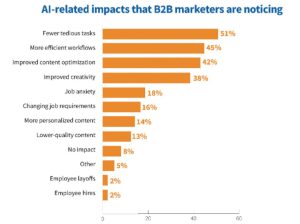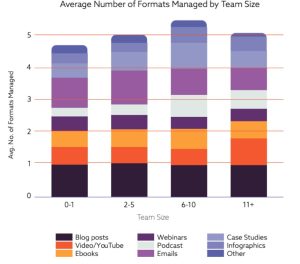Content Marketing and AI – Best Practices
How can we leverage best practices and AI for content marketing?
By Kelly Cutler, Northwestern University
Content Marketing has long been the cornerstone of successful digital marketing strategies. It involves the creation, publishing, and distribution of valuable and relevant information to attract, educate, and retain customers. Challenges associated with content marketing include finding new and interesting ideas, reaching and engaging with a target audience, and driving website traffic, see Figure 2 below. As the digital landscape evolves, marketers must adapt to emerging technologies, including generative AI (genAI), which has the potential to transform how content is created, edited, and personalized. Marketers continue to seek time-saving solutions for content marketing to deliver efficiency and effectiveness across digital platforms.
Figure 1: Image created with Leonardo.AI

Figure 2: Content Marketing Challenges

Generative AI tools like Jasper, Grammarly, Copy.ai and ChatGPT have emerged as tools to reduce production time and monotonous tasks while enabling marketers to focus on more strategic and creative initiatives. In fact, marketers note several significant AI-related impacts, including: fewer tedious tasks, greater efficiency, and improved content optimization, creativity, and personalization, as seen in Figure 3 below.
Figure 3: AI Impacts in Marketing

Moving into 2025, digital marketers will benefit from increased investment in tools and technology to streamline content repurposing, translating, differentiating and measuring, ultimately driving scale and productivity. Below are best practices for utilizing AI for Content Marketing in 2025 and beyond.
Repurposing content across formats is one of the more time-consuming tasks for digital marketers. Providing valuable insights and resources to customers requires managing multiple types of content, often including blog posts, short articles, long articles, videos, data visualizations, email newsletters, podcasts, case studies, testimonials and more, as defined below in Figure 4.
Figure 4: Content Formats

Source: The Content Studio, State of Discontent Report 2024
This starts with identifying evergreen content topics and the more compelling formats for the target audience. Transforming long-form articles for shorter posts, translating content across different languages, and converting text to images or videos are techniques for repurposing content. AI tools like Dall-E, Midjourney, and Leonardo are AI tools for image creation, Figure 5 includes an image created with generative AI image creator, Leonardo.AI.
Figure 5: Image Creation Example

Source: Leonardo.AI
Language translation is another opportunity to use AI tools for productivity. Important considerations in language translation include accuracy, consistency, syntax, grammar, and vocabulary. AI language translation tools should always be rigorously vetted, managed and tested by marketers. Google’s Gemini, QuillBot, DeepL, and SmartCat offer comprehensive language translation and can include services like global data privacy compliance, glossary customization, localization, integration, documentation, dashboards, and accessibility services. Scaling content generation with AI enables marketers to expand their content offerings to a broader global audience while fostering consistency and efficiency across the organization.
Differentiating from competitors is a key strategy for content marketers to achieve and maintain market leadership. Leveraging AI-powered tools enables marketers to not only generate innovative topics and ideas but also systematically monitor and analyze competitors’ content strategies, including topics, formats, and performance metrics. Tools like Crayon, BuzzSumo and Sprout Social provide robust competitor monitoring capabilities. Crayon goes further by providing comprehensive competitive analysis and intelligence, including real-time data aggregation, customer review analysis and product evolution tracking. These advanced insights allow marketers to identify gaps for new content and digital marketing opportunities. Content marketers can expand customer awareness while establishing a distinct identity in an increasingly complex and competitive landscape.
Measuring the performance of content marketing can be a tricky business. Marketers should measure attention, attribution, engagement and return to determine the success of content marketing efforts. Specific key performance indicators for attention monitoring include bounce rates and open rates combined with newer technologies like eye tracking, heat maps, dwell time and cursor location. Marketing attribution is often tracked using web analytics data from Google Analytics, Adobe or Ipsos. Engagement is often tracked using metrics like downloads, likes and shares, click-through-rates, and conversion data. Return is often determined through click-to-open rates, customer acquisition costs and return on investment calculations. Gen AI tools like Salesforce, Watson and ChatGPT can be customized to aggregate, sort and analyze large quantities of data to find performance-related insights. Additionally, Jasper, Hootsuite and SEMRush offer specific AI-driven measurement tools for enhanced reporting, predictive insights, and sentiment analysis to power content marketing performance analysis.
